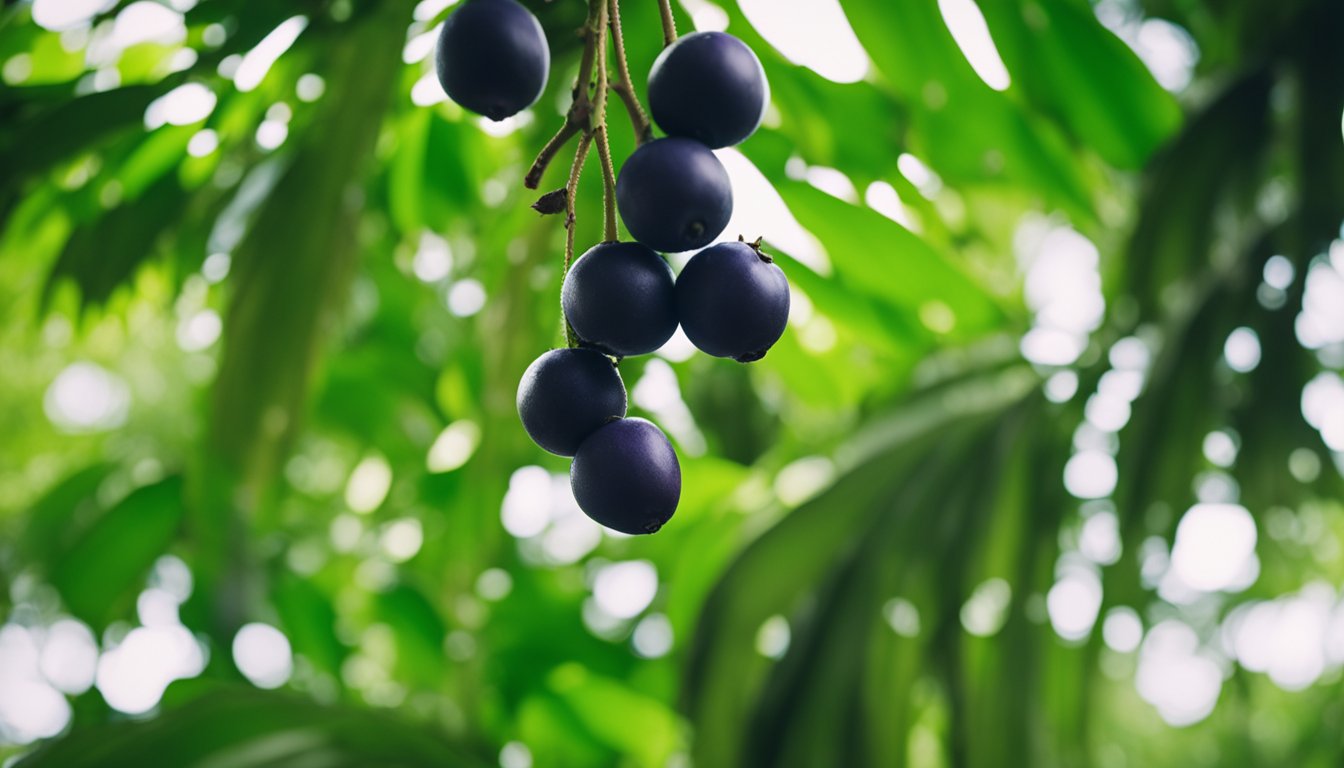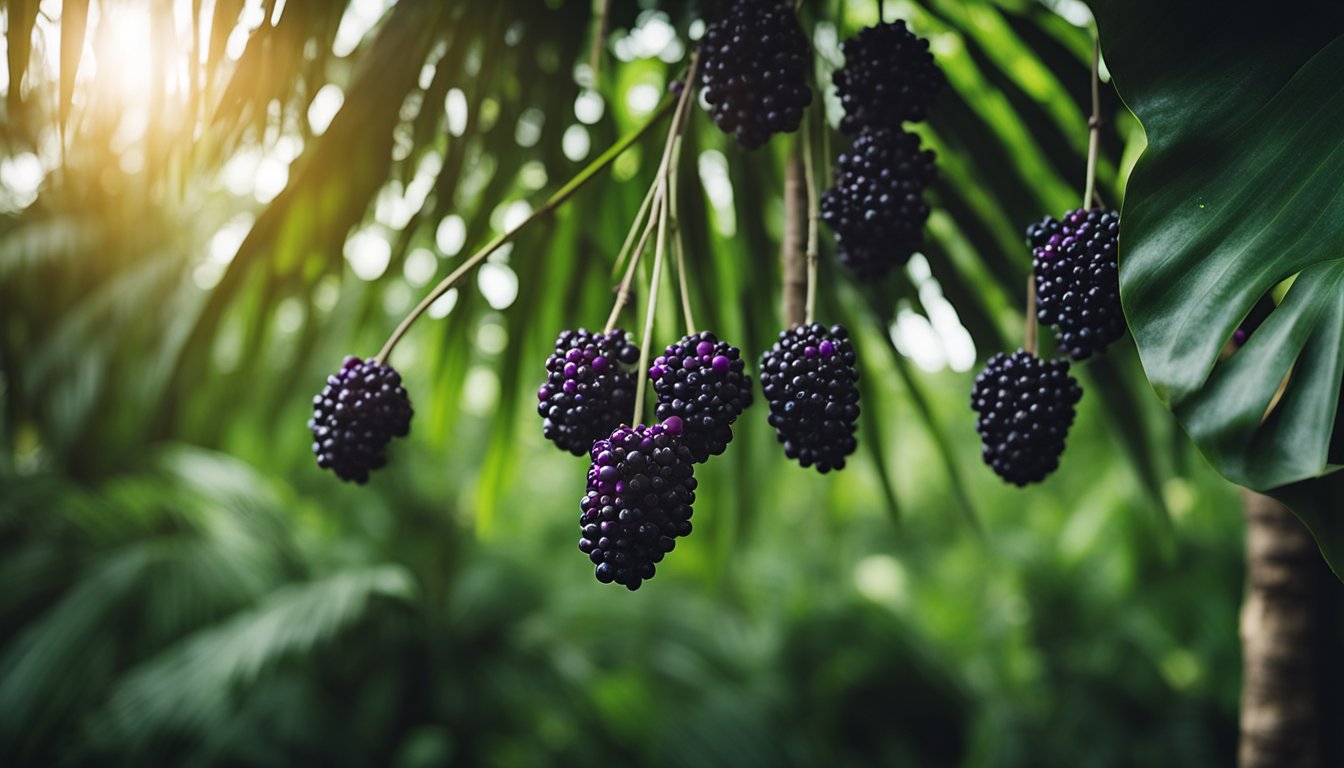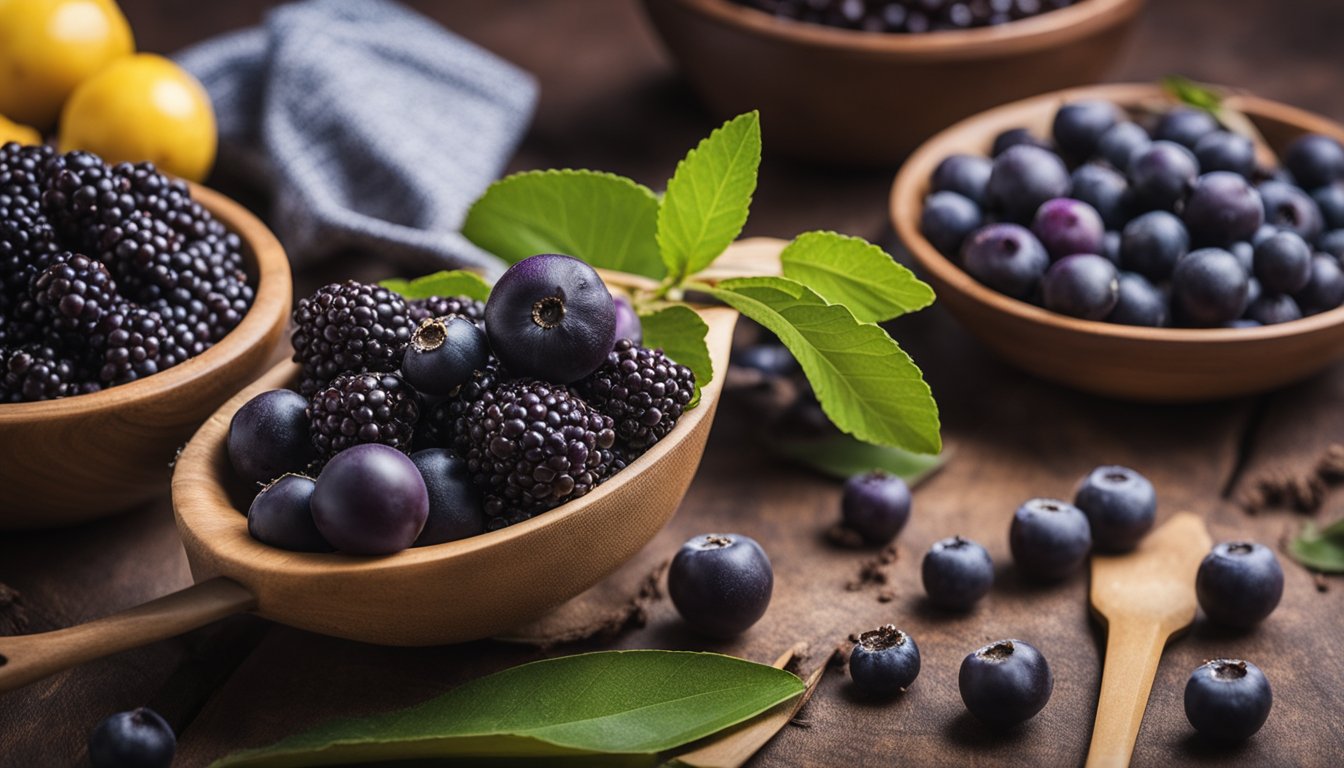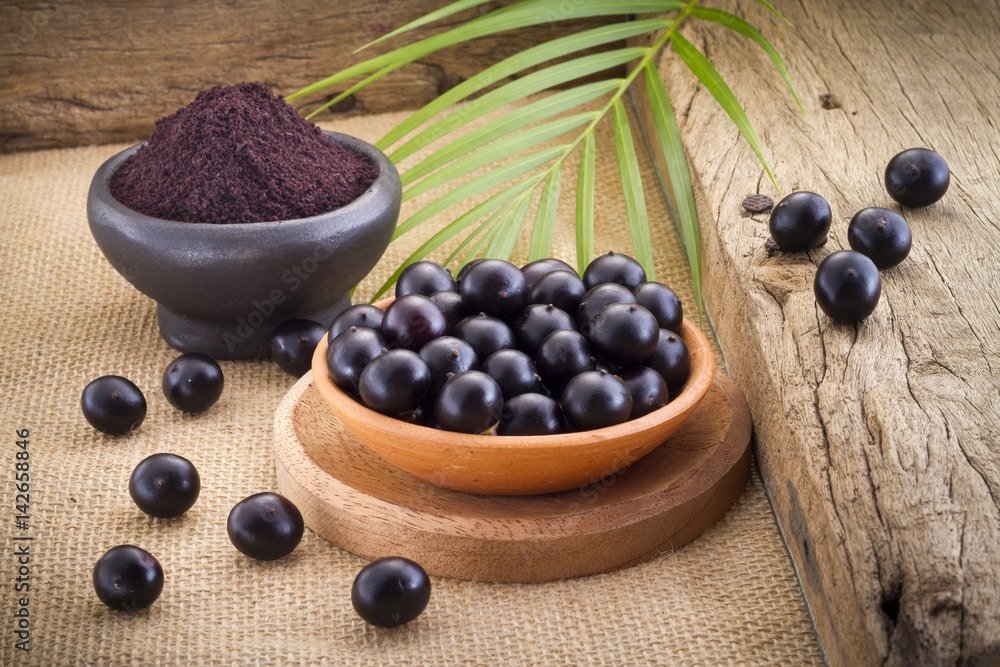The Miracle Fruit: Acai
Is Acai a Miracle Fruit?
Here are some of its virtues to start:
- Antioxidant Powerhouse: Packed with anthocyanins and other antioxidants, acai fights free radicals that can damage cells. Think of it as a shield for your health!
- Heart-Healthy Hero: Good fats and antioxidants in acai might help keep your heart happy by supporting healthy cholesterol levels.
- Fiber Friend: Acai’s got fiber, which keeps your digestive system running smoothly and feeling good.
- Brain Booster: Some studies suggest acai’s antioxidants may benefit brain health and memory. Feed your mind!
- Delicious and Versatile: Blend it into smoothies, top your yogurt, or make an acai bowl – it’s a tasty way to add some goodness to your day.

The proper spelling of the Acai in Portuguese is Açaí, but given the unfamiliarity in the US with the letter “ç” we will continue to refer to the fruit as Acai.
Portuguese pronunciation: “ah-sigh-ee”
But what exactly is the Acai? The fruit is small, dark purple and hailing from the acai palm tree. Acai has made a name for itself in the health and wellness sphere. They are native to the rainforests of South America, where they’ve been a staple in the diet of the indigenous peoples for centuries.
Characterized by their rich color and unique, slightly tart flavor, these berries have gained international acclaim, often labeled as a superfood due to their high antioxidant content, fiber, and heart-healthy fats. Although these berries can be consumed fresh in their native growing regions, they are typically found in other parts of the world as freeze-dried powders, purées, or included in products such as juice blends and nutritional supplements.
While acai berries are indeed nutrient-rich, it is essential to approach any “miracle” claims with a facts and research. The miracle fruit claim might be too generous but it is hard to argue against its superfood qualities.
Acai Origins and Varieties

The acai berry, deriving from the Euterpe oleracea palm, is native to rainforests of Central and South America, with a significant presence in Brazil. This section delves into the trees’ habitat as well as the methods of cultivation and harvesting employed.
Acai Palm Trees and Habitat
The acai palm flourishes predominantly in the floodplain areas of the Amazon rainforest. These tall, slender palms can reach heights of over 25 meters, marking the skyline of South American tropics with their distinct, pinnate leaves. The specific species Euterpe oleracea is predominantly found within Brazilian territories, although its range extends across various countries in Central and South America.
Cultivation and Harvesting
The harvesting of acai berries is a labor-intensive process conducted chiefly in Brazil. Acai palms are cultivated for not only their fruit but also their other products, such as hearts of palm. Berries grow in clusters and, once ripened, require hand-picking which necessitates climbers to deftly ascend the tall palms. The practice of growing and collecting acai berries holds a considerable cultural and economic significance to the Brazilian people, especially within the indigenous communities. The surge in global demand for these berries has underscored the importance of sustainable practices to ensure the longevity and health of these vital ecosystems.
Nutritional Profile and Health Benefits

Acai berries offer a complex array of vitamins and minerals alongside potent antioxidants, contributing to numerous health benefits. This nutrient-dense fruit supports heart health and may influence cholesterol levels positively.
Vitamins and Minerals
Acai berries are a rich source of various vitamins and minerals. They contain vitamin A, which is essential for skin, eye, and immune health, and vitamin C, which is known for its immunity-boosting properties. These berries also provide important minerals like calcium, promoting bone health, iron, crucial for blood health, and potassium, which is vital for heart and muscle function. The presence of magnesium aids in numerous biochemical reactions, while zinc is pivotal for immunity and healing.
Furthermore, they offer a valuable amount of copper and manganese, both important for overall wellness. The table below shows a detail of the key nutrients found in a 100g serving of acai berries:
| Nutrient | Amount | % Recommended Daily Intake (RDI) |
|---|---|---|
| Vitamin A | 26 mg (as retinol equivalents) | 3% |
| Vitamin C | 9.6 mg | 11% |
| Vitamin E | 1.4 mg (alpha-tocopherol equivalents) | 9% |
| Vitamin K | 0.6 µg | 1% |
| Thiamin (Vitamin B1) | 0.09 mg | 6% |
| Riboflavin (Vitamin B2) | 0.14 mg | 8% |
| Niacin (Vitamin B3) | 0.75 mg | 5% |
| Pantothenic Acid (Vitamin B5) | 0.34 mg | 7% |
| Vitamin B6 | 0.1 mg | 8% |
| Folate | 10 µg | 3% |
| Choline | 11 mg | 2% |
| Potassium | 121 mg | 3% |
| Magnesium | 20 mg | 5% |
| Calcium | 35 mg | 4% |
| Iron | 0.6 mg | 4% |
| Phosphorus | 47 mg | 3% |
| Manganese | 0.8 mg | 38% |
| Copper | 0.13 mg | 14% |
| Zinc | 0.6 mg | 4% |
| Selenium | 1.4 µg | 2% |
Antioxidants and Phytochemicals
Acai berries are particularly noted for their high levels of antioxidants, especially anthocyanins, which are compounds believed to be protective against oxidative stress. These powerful substances help neutralize the damaging effects of free radicals, which are linked to chronic diseases, such as cancer. The anti-inflammatory properties of these phytochemicals may also alleviate inflammation, which is a root cause of many health issues.
Antioxidant Arsenal:
- Anthocyanins: Vibrant pigments giving acai its rich color, these potent antioxidants neutralize free radicals and shield cells from damage.
- Phenolic Acids: Ferulic and caffeic acid, among others, scavenge free radicals before they can cause harm.
- Vitamin E: This trusty fat-soluble antioxidant protects cell membranes from oxidative damage.
ORAC Power:
Oxygen Radical Absorbance Capacity (ORAC) measures an antioxidant’s free-radical-fighting prowess. Acai boasts a high ORAC value, ranking among the top fruits and berries, making it a formidable antioxidant force.

Benefits of Acai’s Antioxidant Power:
- Reduced Inflammation: Free radicals trigger inflammation, a key factor in many chronic diseases. Acai’s antioxidants quell inflammation, protecting against conditions like arthritis and heart disease.
- Heart Health Boost: Acai’s antioxidants may lower LDL (“bad”) cholesterol and raise HDL (“good”) cholesterol, reducing heart disease risk.
- Neuroprotective Shield: Acai’s antioxidants may guard brain cells from damage, potentially delaying the onset of neurodegenerative diseases like Alzheimer’s.
- Cancer Prevention Potential: Studies hint at acai’s anti-cancer properties, though more research is needed.
Heart Health and Cholesterol
The consumption of acai may be beneficial to cardiovascular health due to its potential effects on cholesterol levels. These berries have been found to have a positive impact on blood sugar levels, as well as to promote a decrease in LDL cholesterol, which is often termed ‘bad’ cholesterol. The fiber content in acai also aids in maintaining a healthy digestive system and contributes to the overall health of the heart by assisting in the regulation of cholesterol levels.
Acai in Diet and Weight Management

Integrating acai into one’s diet can contribute to weight management efforts, providing essential nutrition while being mindful of calories and fat content.
Acai Bowls and Smoothies
Acai bowls and smoothies have gained popularity as tasty options for incorporating the nutrient-dense acai berry into a balanced diet. The typical acai bowl is a blend of frozen acai pulp, other fruits, and sometimes nut milks, garnished with a variety of toppings such as nuts, seeds, and granola. This meal can be a fiber-rich breakfast or snack that may help with satiety and thus aid in weight loss efforts.
However, one should be mindful of the caloric intake as these bowls can sometimes be high in sugar and calories due to added sweeteners and high-calorie toppings.
Acai smoothies, on the other hand, can be customized to contain fewer calories by limiting sweeteners and high-calorie fruits. These smoothies often combine acai with other low-calorie, nutrient-rich fruits and vegetables, making them a convenient option for weight management and nutrient intake. They provide healthy fats, particularly omega-3 fatty acids, which are beneficial for overall health.
Acai Bowl Recipe

Ingredients
- 1 packet (100g) frozen acai berry blend (unsweetened if possible)
- 1/2 cup frozen banana (pre-sliced or broken into chunks)
- 1/2 cup frozen berries (mixed berries, blueberries, or strawberries are all good options)
- 1/4 cup milk of your choice (dairy or non-dairy)
- 1 tablespoon nut butter (optional)
- Honey or other sweetener (optional, to taste)
Instructions
- Combine all ingredients in a high-powered blender.
- Blend until smooth and creamy, adding more milk or liquid if needed to reach desired consistency.
- Pour the acai mixture into a bowl.
- Get creative with your toppings! Here are some ideas:
- Fresh fruit slices (banana, mango, pineapple, etc.)
- Granola or chopped nuts
- Chia seeds or hemp seeds
- Coconut flakes
- Drizzle of nut butter or honey
Tips
- Use frozen ingredients for the best texture and to keep the acai bowl cold.
- If you don’t have frozen acai berries, you can use acai powder, but the flavor and texture will be slightly different.
- Experiment with different toppings to find your favorite combinations.
- You can also add protein powder, greens powder, or other superfoods to your acai bowl for an extra nutritional boost.
Here are some variations you can try:
- Tropical Acai Bowl: Use pineapple juice instead of milk and top with fresh pineapple, mango, and coconut flakes.
- Green Acai Bowl: Add a handful of spinach or kale to the blender for a nutrient-rich boost.
- Chocolate Acai Bowl: Add a tablespoon of cocoa powder to the blender and top with fresh berries and chopped dark chocolate.
Enjoy your delicious and healthy acai bowl!








